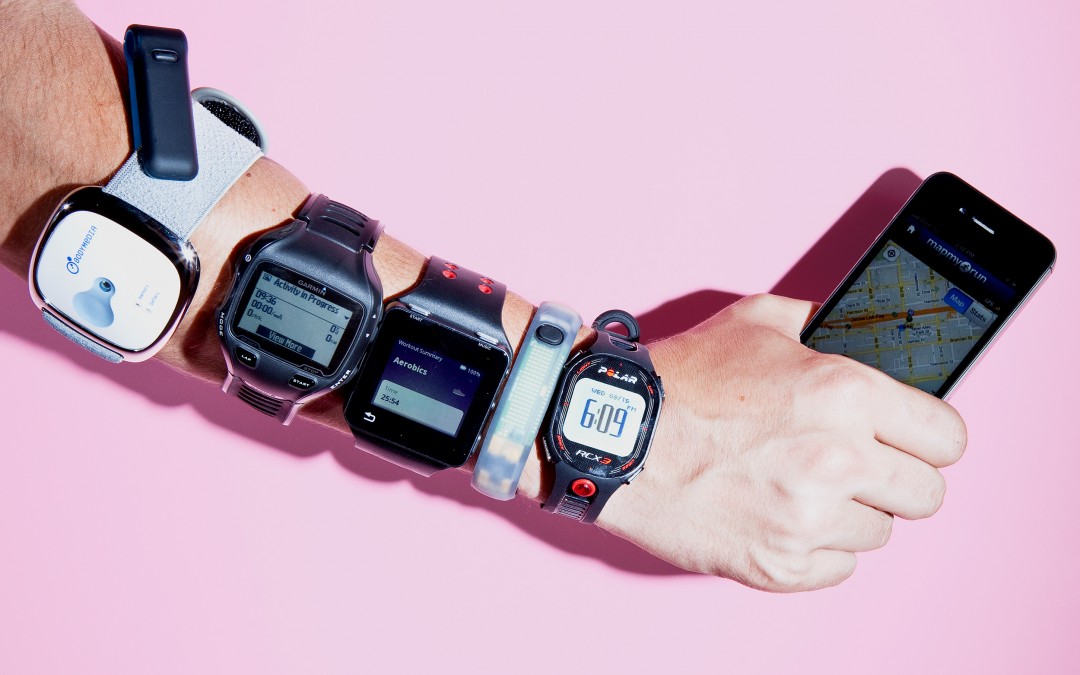In the wake of Jawbone releasing the Up Move and Up3 this week, the fight for the ultimate fitness tracker has thrown the wearables race into a whole new realm.
With market forecasts of wearables dominating the holiday sales this year, we decided to take a look and compare the competition to see where your money’s best spent. It might just help you achieve those New Year’s resolutions once and for all.
UP3 // $179
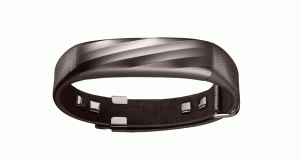
Dropped like a smart bomb this week, the newest wearable by Jawbone is the self-proclaimed “First Truly Wearable Heart Rate Monitor.” True that. You can wear this to bed, in the shower and the battery life on it is great —
lasting as long as a week between charges. Rather that using energy-hungry sensors to track your cardiac activity, this works by sending a little pulse into your body called
bioimpedance, and measures its results, including your respiratory rate. Design notwithstanding, the UP3 is a very smart investment that could rekindle your lost love for long-distance running.
Jawbone UP3 Website
UP Move // $49
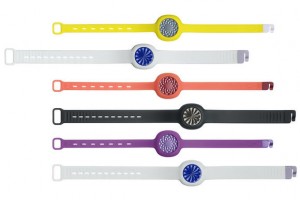
Think a weeklong charge is great? Well the UP Move’s battery boasts enough juice to last 6 months long, not to mention is dirt cheap. It can either be worn on the wrist, or can be clipped onto clothing, counting steps and measuring calories burned, and your sleep quality. This would be a great investment for someone who’s truly focused on their health, but doesn’t need all the bells and whistles of a full-blown smartwatch. Bonus is that it comes in multiple color options, too.
Jawbone UP Move Website
Moov // $80
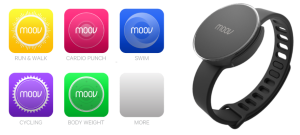
This handsome little health tracker looks quite a bit like the Moto 360 smartwatch, but is not anything like it. Positioning itself primarily to people who genuinely want to get healthy, the unique selling factor here is the Moov’s AI coach apps. While most wearables are touted to claim that giving “motivation” to their user is a huge facet of their platform, this device in particular has partner apps to accompany training programs in running, boxing, swimming, cycling and body weight exercises. Available just in time for the holidays.
Moov website
Nike Fuelband SE // $99
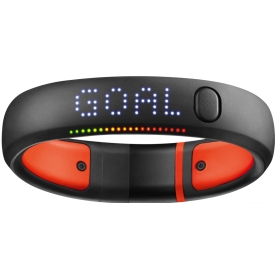
The price was recently knocked down, most likely due to all the other great competitors out there who essentially do the same thing. The upside to the Nike variety is its design and feel – if you’ve felt the quality and weight of the rubber material over your wrist it is something you will understand. While it’s not been recommended for serious athletes for some inconsistency reasons, it’s a sure pleaser for a running enthusiast who’s loved the Nike brand since day one. The design and color options are fantastic, too.
Nike Fuelband website
Samsung Gear Fit // $141
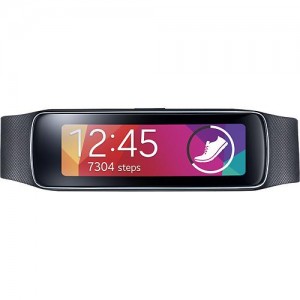
Samsung’s line of smartwatches have been getting
accolades from tech experts since day 1. They set the tone for the wearables race from the beginning, and have continually stayed on top as one of the key players by pushing innovation and great design past Motorolla and other competitors like Pebble, which offer very different things with equally elegant design and functionality. The Gear Fit fitness tracker is no exception – it’s a beautiful, a reliable way to track your fitness goals and accomplishments, syncing seamlessly to your other Android devices. The battery lasts up to 5 days on a single charge, and this wrist candy is water and dust resistant. With this price point, we’d recommend it for someone who not only appreciates a good run with analytics to back up their fitness regime, but for the extra bit of geek who will appreciate all the tech that goes with it.
Samsung Gear Fit Website
The Future of Fitness Trackers?
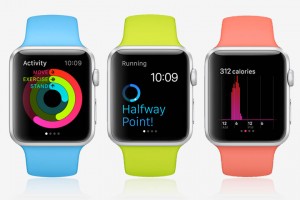
Just like any other realm of the human experience, we can only make decisions based on the information we have in front of us. As of today, we can confidently say that these are some of the best fitness trackers in the world — for now.
AppleWatch is slated to come out early 2015, which means you won’t have it in time for the holidays, but it will be another option if you’re willing to hold out on the sales season and wait a little longer for this hotly anticipated little piece of technology.
At the keynote, the company emphasized the AppleWatch as a fitness companion that will incorporate lots of interactive features to keep the user active and healthy, such as setting daily and weekly activity goals, keeping tabs on how much you move in a day, and so on. With the price tag touted to start at $349, it’s granted to do a lot more things than be a fitness tracker.
 Dropped like a smart bomb this week, the newest wearable by Jawbone is the self-proclaimed “First Truly Wearable Heart Rate Monitor.” True that. You can wear this to bed, in the shower and the battery life on it is great — lasting as long as a week between charges. Rather that using energy-hungry sensors to track your cardiac activity, this works by sending a little pulse into your body called bioimpedance, and measures its results, including your respiratory rate. Design notwithstanding, the UP3 is a very smart investment that could rekindle your lost love for long-distance running.
Jawbone UP3 Website
Dropped like a smart bomb this week, the newest wearable by Jawbone is the self-proclaimed “First Truly Wearable Heart Rate Monitor.” True that. You can wear this to bed, in the shower and the battery life on it is great — lasting as long as a week between charges. Rather that using energy-hungry sensors to track your cardiac activity, this works by sending a little pulse into your body called bioimpedance, and measures its results, including your respiratory rate. Design notwithstanding, the UP3 is a very smart investment that could rekindle your lost love for long-distance running.
Jawbone UP3 Website
 Think a weeklong charge is great? Well the UP Move’s battery boasts enough juice to last 6 months long, not to mention is dirt cheap. It can either be worn on the wrist, or can be clipped onto clothing, counting steps and measuring calories burned, and your sleep quality. This would be a great investment for someone who’s truly focused on their health, but doesn’t need all the bells and whistles of a full-blown smartwatch. Bonus is that it comes in multiple color options, too.
Jawbone UP Move Website
Think a weeklong charge is great? Well the UP Move’s battery boasts enough juice to last 6 months long, not to mention is dirt cheap. It can either be worn on the wrist, or can be clipped onto clothing, counting steps and measuring calories burned, and your sleep quality. This would be a great investment for someone who’s truly focused on their health, but doesn’t need all the bells and whistles of a full-blown smartwatch. Bonus is that it comes in multiple color options, too.
Jawbone UP Move Website
 This handsome little health tracker looks quite a bit like the Moto 360 smartwatch, but is not anything like it. Positioning itself primarily to people who genuinely want to get healthy, the unique selling factor here is the Moov’s AI coach apps. While most wearables are touted to claim that giving “motivation” to their user is a huge facet of their platform, this device in particular has partner apps to accompany training programs in running, boxing, swimming, cycling and body weight exercises. Available just in time for the holidays.
Moov website
This handsome little health tracker looks quite a bit like the Moto 360 smartwatch, but is not anything like it. Positioning itself primarily to people who genuinely want to get healthy, the unique selling factor here is the Moov’s AI coach apps. While most wearables are touted to claim that giving “motivation” to their user is a huge facet of their platform, this device in particular has partner apps to accompany training programs in running, boxing, swimming, cycling and body weight exercises. Available just in time for the holidays.
Moov website
 The price was recently knocked down, most likely due to all the other great competitors out there who essentially do the same thing. The upside to the Nike variety is its design and feel – if you’ve felt the quality and weight of the rubber material over your wrist it is something you will understand. While it’s not been recommended for serious athletes for some inconsistency reasons, it’s a sure pleaser for a running enthusiast who’s loved the Nike brand since day one. The design and color options are fantastic, too.
Nike Fuelband website
The price was recently knocked down, most likely due to all the other great competitors out there who essentially do the same thing. The upside to the Nike variety is its design and feel – if you’ve felt the quality and weight of the rubber material over your wrist it is something you will understand. While it’s not been recommended for serious athletes for some inconsistency reasons, it’s a sure pleaser for a running enthusiast who’s loved the Nike brand since day one. The design and color options are fantastic, too.
Nike Fuelband website
 Samsung’s line of smartwatches have been getting accolades from tech experts since day 1. They set the tone for the wearables race from the beginning, and have continually stayed on top as one of the key players by pushing innovation and great design past Motorolla and other competitors like Pebble, which offer very different things with equally elegant design and functionality. The Gear Fit fitness tracker is no exception – it’s a beautiful, a reliable way to track your fitness goals and accomplishments, syncing seamlessly to your other Android devices. The battery lasts up to 5 days on a single charge, and this wrist candy is water and dust resistant. With this price point, we’d recommend it for someone who not only appreciates a good run with analytics to back up their fitness regime, but for the extra bit of geek who will appreciate all the tech that goes with it.
Samsung Gear Fit Website
Samsung’s line of smartwatches have been getting accolades from tech experts since day 1. They set the tone for the wearables race from the beginning, and have continually stayed on top as one of the key players by pushing innovation and great design past Motorolla and other competitors like Pebble, which offer very different things with equally elegant design and functionality. The Gear Fit fitness tracker is no exception – it’s a beautiful, a reliable way to track your fitness goals and accomplishments, syncing seamlessly to your other Android devices. The battery lasts up to 5 days on a single charge, and this wrist candy is water and dust resistant. With this price point, we’d recommend it for someone who not only appreciates a good run with analytics to back up their fitness regime, but for the extra bit of geek who will appreciate all the tech that goes with it.
Samsung Gear Fit Website
 Just like any other realm of the human experience, we can only make decisions based on the information we have in front of us. As of today, we can confidently say that these are some of the best fitness trackers in the world — for now.
AppleWatch is slated to come out early 2015, which means you won’t have it in time for the holidays, but it will be another option if you’re willing to hold out on the sales season and wait a little longer for this hotly anticipated little piece of technology.
At the keynote, the company emphasized the AppleWatch as a fitness companion that will incorporate lots of interactive features to keep the user active and healthy, such as setting daily and weekly activity goals, keeping tabs on how much you move in a day, and so on. With the price tag touted to start at $349, it’s granted to do a lot more things than be a fitness tracker.
Just like any other realm of the human experience, we can only make decisions based on the information we have in front of us. As of today, we can confidently say that these are some of the best fitness trackers in the world — for now.
AppleWatch is slated to come out early 2015, which means you won’t have it in time for the holidays, but it will be another option if you’re willing to hold out on the sales season and wait a little longer for this hotly anticipated little piece of technology.
At the keynote, the company emphasized the AppleWatch as a fitness companion that will incorporate lots of interactive features to keep the user active and healthy, such as setting daily and weekly activity goals, keeping tabs on how much you move in a day, and so on. With the price tag touted to start at $349, it’s granted to do a lot more things than be a fitness tracker.

